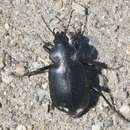mk
имиња во трошки


Calosoma is a genus of large ground beetles that occur primarily throughout the Northern Hemisphere, and are referred to as caterpillar hunters or caterpillar searchers. Many of the 167 species are largely or entirely black, but some have bright metallic coloration. They produce a foul-smelling spray from glands near the tip of the abdomen. They are recognizable due to their large thorax, which is almost the size of their abdomen and much wider than their head.[1]
Calosoma has about 20 subgenera, including some former genera such as Callisthenes.[2][3]
In 1905, Calosoma sycophanta was imported to New England for control of the spongy moth. The species is a voracious consumer of caterpillars during both its larval stage and as an adult, as are other species in the genus. For this reason, they are generally considered beneficial insects. Several species of this beetle, most notably the black calosoma (Calosoma semilaeve) are especially common in the California area.
 Calosoma planicolle
Calosoma planicolle  Calosoma senegalense
Calosoma senegalense  Calosoma scrutator by Alejandro Santillana "Insects Unlocked" Project, University of Texas at Austin
Calosoma scrutator by Alejandro Santillana "Insects Unlocked" Project, University of Texas at Austin Calosoma is a genus of large ground beetles that occur primarily throughout the Northern Hemisphere, and are referred to as caterpillar hunters or caterpillar searchers. Many of the 167 species are largely or entirely black, but some have bright metallic coloration. They produce a foul-smelling spray from glands near the tip of the abdomen. They are recognizable due to their large thorax, which is almost the size of their abdomen and much wider than their head.
Calosoma has about 20 subgenera, including some former genera such as Callisthenes.